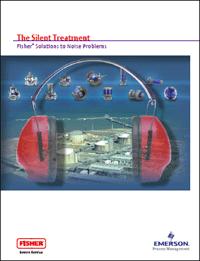 Those that work or have visited industrial processes know how loud they can be with the fluids flowing through the process. Emerson’s Fisher Valves & Instruments team has a great piece, The Silent Treatment—Fisher Solutions to Noise Problems.
Those that work or have visited industrial processes know how loud they can be with the fluids flowing through the process. Emerson’s Fisher Valves & Instruments team has a great piece, The Silent Treatment—Fisher Solutions to Noise Problems.
It addresses common sources by industry, the science behind noise generation, factors impacting the intensity and frequency of the noise, and ways to reduce this noise.
Let’s focus on the first few items starting with common sources by industry. In the power industry, high steam pressures and large pressure drops can potentially cause excessive noise and acoustic induced vibration. Control valve noise can be a concern in the main steam, auxiliary steam, turbine bypass, and sky vent systems.
For the hydrocarbon-based industries:
Applications… include compressor antisurge, gas to flare, and other large pressure drop applications that are driven by chemical reaction, thermal processes, vertical head, or compressors.
For process industries including chemicals, metals & mining, pulp & paper, and food & beverage:
…use of steam is common in these industries for a variety of applications. Large pressure drop steam applications can be associated with noise generation.
The science of noise begins with an understanding of how noise is defined:
Sound is produced by fluctuating pressure waves that arise from the flow of fluid through the control valve. The specific sources are either mechanical or fluid structure in nature. Dominant fluid generated sources are specific to hydrodynamic (liquid) flow and aerodynamic (gas or vapor) flow.
Mechanical noise:
…results from the physical vibration of components in control valves such as worn plugs rattling in cages… Another source of mechanical noise is resonance of movable parts within the control valve, which are characterized by a single pitch, or tone, and may reach frequencies of 7,000 Hz.
Hydrodynamic noise:
…occurs in liquid flows and is predominately caused by cavitation. Cavitation consists of the formation and collapse of vapor cavities in the flowstream. This occurs when the pressure drops to the vapor pressure of the fluid. The energy released in this process is converted into pressure fluctuations that create sound waves. This noise occurs over a wide frequency range and is often described as sounding like gravel flowing through the pipe.
Aerodynamic noise is primarily caused by flow turbulence. Typical locations include:
…the throttling region where the relative fluid pressure is low and the fluid speed is high. High levels of fluid turbulence can result from the jets formed in the control valve trim. The second location is the region between the control valve trim and the body wall where high speed fluid impingement can result in significant turbulence…
Another location of interest is the region downstream of the control valve trim. Here the velocity-related turbulence in the control valve outlet and downstream pipe acts as an independent noise source.
Sources of noise can come from a point source, such as a flare, or a line source, such as a pipeline.
Addressing the causes of noise can come from source treatments and path treatments. For source treatments:
A principle aerodynamic strategy is to break the flow stream into many small, parallel flow passages…
Source treatments prevent noise at its source, which can involve the control valve. Common source treatments include noise-attenuation control valve trims, inline diffusers, and vent diffusers that minimize turbulence.
In path treatments, noise can be reduced:
…by impeding the propagation and transmission of the sound waves… Path treatments help eliminate noise heard outside of the pipe wall by increasing the resistance of the noise path. Typical path treatments include increasing the pipe thickness, adding acoustical or thermal insulation, or adding inline pipe silencers.
Fisher control valves have many noise attenuating technologies, such as:
- Whisper Trim I Cage
- Whisper Trim III Cage
- WhisperFlo Cage
- Vee-Ball Control Valve with Rotary Attenuator
- V260A Control Valve with Aerodome Attenuator
- Vent Diffusers
- Inline Diffusers
If the noise in your facility needs improvement, check out The Silent Treatment, which describes these solutions and their application in greater detail. There is also a video showing sources and solutions to noise issues.
| iTunes




